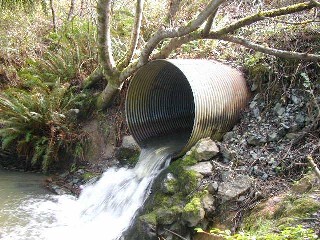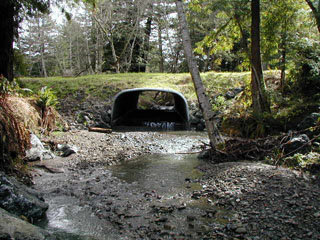
|
Migration Barrier Removal
 Human caused barriers to fish passage include road/stream intersections, pipeline or other infrastructure crossings, erosion control/flood control structures (rip-rap, concrete channels, etc), and dams which block or delay upstream migration. These barriers impact both adult and juvenile fish by preventing full use of available habitat or by altering habitat or hydraulic conditions. Numerous road/stream crossings often cross multiple road ownerships within a watershed. Aside from making habitat inaccessible, passage impediments and delays in migration can cause injury or death to adult and juvenile fish attempting to migrate upstream. Human caused barriers to fish passage include road/stream intersections, pipeline or other infrastructure crossings, erosion control/flood control structures (rip-rap, concrete channels, etc), and dams which block or delay upstream migration. These barriers impact both adult and juvenile fish by preventing full use of available habitat or by altering habitat or hydraulic conditions. Numerous road/stream crossings often cross multiple road ownerships within a watershed. Aside from making habitat inaccessible, passage impediments and delays in migration can cause injury or death to adult and juvenile fish attempting to migrate upstream.
The Five Counties Program has aggressively targeted Migration Barrier Removal on County Roads as one of its top priorities since 1998. Through the Five Counties Migration Barrier Inventory, consulting biologist Ross Taylor identified stream crossings on County Roads that prevent or impede the upstream migration of salmonid species. These barriers were prioritized in our Migration Barrier Ranking Matrix, which has driven the implementation stage of the program for several years. As our Migration Barrier Removal Progress Matrix indicates, the program has completed 65 migration barrier improvement projects, restoring access to over 146 miles of habitat. Refer to the Project Gallery page for select project photos and to this current map for locations of existing and completed barrier projects.
Summary by County
Projects in individual counties have been implemented as follows:
- Del Norte County has completed 7 Migration Barrier Removal Projects from 2000-2013, restoring access to approximately 10.8 miles of salmonid habitat. The County has completed these projects with funding from the National Fish and Wildlife Foundation, California Department of Fish and Wildlife, the California Coastal Conservancy. and the Del-Norte County Community Development Department.
- Humboldt County has implemented 26 Migration Barrier Removal Projects to date, restoring access to over 39 miles of habitat. These projects have been funded through the California Department of Fish and Wildlife's Fisheries Restoration Grant Program, California Coastal Conservancy, NOAA Fisheries, and Pacific State Marine Fisheries. The County has slated additional projects for construction next year.
- Mendocino County completed 12 Fish Passage Improvement Projects from 2001 - 2011, restoring access to over 19 miles of habitat for coho salmon & steelhead trout. The County completed its highest remaining priority, Ryan Creek in 2011. This project replaced a large concrete box structure with a natural bottom concrete arch. Mendocino has completed its projects with funding from the National Fish and Wildlife Foundation, the California Department of Fish and Wildlife, the National Association of Counties' (NACo) Coastal Counties Restoration Initiative and the Mendocino County Department of Transportation.
- Siskiyou County has completed 8 Migration Barrier Removal Projects from 1998 - 2011, restoring access to approximately 51 miles of salmonid habitat. The County has completed these projects through funding from Office of Emergency Services, California Department of Fish and Wildlife, Bureau of Reclamation and the Siskiyou County Department of Public Works. The County's ability to construct and design the projects "in-house" has substantially cut down on project costs. For each project, the County has employed a different method of construction and design.
- Trinity County has completed 12 Migration Barrier Removal Projects between 2000 & 2012, restoring access to over 25 miles of salmonid habitat. The County has completed these projects through funding from the Department of Fish & Game S.B. 271 Grant Program, State Water Resources Control Board - Proposition 204, Coastal Conservancy, NOAA Open Rivers, US Fish & Wildlife Service, National Fish & Wildlife Foundation, and Trinity County in-kind matching funds.
Several construction techniques have been used in these fish passage projects. Coho Salmon spawning in Rush Creek, Trinity County were observed in early November! Check out the video here, courtesy of Eric Wiseman, Fisheries Biologist.
An inventory of the Russian River migration barriers was also completed by Ross Taylor & Associates. Download the inventory (PDF file): Russian River Migration Barrier Inventory. Margaret Lang completed a barrier inventory of Caltrans District 1 crossing structures. Download the inventory (PDF) file: Caltrans District 1 Pilot Fish Passage Assessment Study: Volume 1 - Overall Results.
The 5C recognizes that a comprehensive fish passage program is vital for identifying, prioritizing, and treating migration barriers so that unimpeded migration of regional salmonid populations can occur. Aside from pursuing migration barrier removal projects, the 5C also participates in the Fish Passage Forum. The Forum is a collaboration of public, private, and other organizations to protect and restore listed anadromous fish and aquatic organisms.
For more information on the Migration Barrier Removal Program, contact us.

Prior to replacement, the culvert shown above, located on South Fork Anker Creek in Humboldt County, not only served as a complete barrier to all life stages of salmonids, but was also extremely undersized. The replacement crossing, shown below affords full passage to all life stages, higher flows, and associated channel bedload and debris.

|
|

|

|
|
